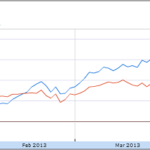ETFs holding dividend-paying stocks trailed the broad market since the implosion in early 2009 primarily because of the rebound in technology shares which tend to not pay out dividends given the nature of the industry. It’s generally the more mature cycle Industrials, Telecoms, Utilities and Financials that tend to pay dividends over time. However, analysts are now citing a variety of factors that may facilitate out-performance in the dividend stock genre. A recent report by Deutsche Bank echoes this sentiment. Primary drivers of this anticipate market out-performance include:
- Very poor alternatives for income in savings, money markets, CDs and Treasuries
- The specter of eventual interest rate hikes would be bad for bond prices and yields increase
- Many of the companies more prone to dividend cuts have already done so (like Financials)
- Healthy companies that survived the storm are sitting on cash hoards that will eventually be utilized in cash buybacks or dividend increases
The pros recommend focusing on high yield stocks that are actually increasing their dividends, not just presenting a high current dividend as a result of recent share price declines. When an individual issue is yielding well into the double digits, that’s often a sign that a reduction in the dividend is imminent and the market has priced that in while the fools rush in. This is what we saw in many of the Financials during the crash, as well as other venerable dividend payers like Dow Chemical (DOW) and General Electric (GE) as well before they shocked the investment community with dividend cuts.
Some ETFs that focus specifically on dividend paying stocks include:
(VIG) – Vanguard Dividend Appreciation ETF – The intent of this ETF is to mimic the Mergent Dividend Achievers Select index which is charged with holding shares of companies that have a record of increasing dividends. This ETF sports a modest yield of 2.1% and holds primarily large blue chip stocks. Within the top 10 holdings, there is only one financial being Wells- Fargo (WFC). Other holdings are a mix of industrials, energy and consumer products companies.
(XLU) – Utilities Select Sector SPDR Fund – With a 4.3% yield, this Utility stock ETF is generally viewed as a more stable, income oriented holding without anticipation of rapid capital appreciation. XLU did not decline nearly as badly as the S&P500 during the 2008-2009 meltdown, but it has underperformed during the rebound.
(IRO) – Claymore/Zacks Dividend Rotation ETF – This ETF follows the Zacks Dividend Rotation index which holds foreign ADRs and Master Limited Partnership shares as well, so it’s not your typical US Large cap blend. The yield is 3.8%. Top holdings include energy, tobacco and a mix of international equities as well.
(FDD) – First Trust DJ STOXX Select Dividend 30 Index Fund – For a mix of European dividend payers, this ETF seeks to mimic the STOXX(R) Europe Select Dividend 30 index. The current yield stands at 3.9%. If you feel the recent jitters over Greece are overdone, perhaps this ETF is suitable for growth and income.
(DTD) – WisdomTree Total Dividend Fund – At 2.8%, this ETF seeks to replicate the aptly named Wisdom Tree Dividend index. The top holdings are comprised of your typical large Dow components that pay a fairly attractive dividend like Verizon (VZ), Exxon Mobil (XOM) and Pfizer (PFE).
(SDY) – SPDR S&P Dividend ETF – Yielding 3.70%, this is one of the more well-known dividend ETFs which is meant to replicate the S&P High Yield Dividend Aristocrats index. In reviewing historical returns of SDY vs. SPY, the S&P500 ETF, the returns track roughly on top of each other, but the 3.70% yield is 2 percentage points higher than the current 1.70% yield on SPY which makes it a compelling story.
(DWX) – SPDR S&P International Dividend ETF – For a mix of international exposure and dividend yield, this ETF looks overseas for income and has top holdings that include the big cap pharma AstraZeneca as well as the Russia territory telecom Mobile Telesystems.
While there are other exchange traded funds and closed-end funds that have much higher yields like Preferred Stocks and Junk Bond Funds, they don’t fall into this classification of focusing on stocks that pay consistent, growing dividends. Those ETFs pay higher yields given the specific classification and focus of each.
Disclosure: No position in any stocks or ETFs covered in this article.









{ 0 comments… add one now }
{ 1 trackback }